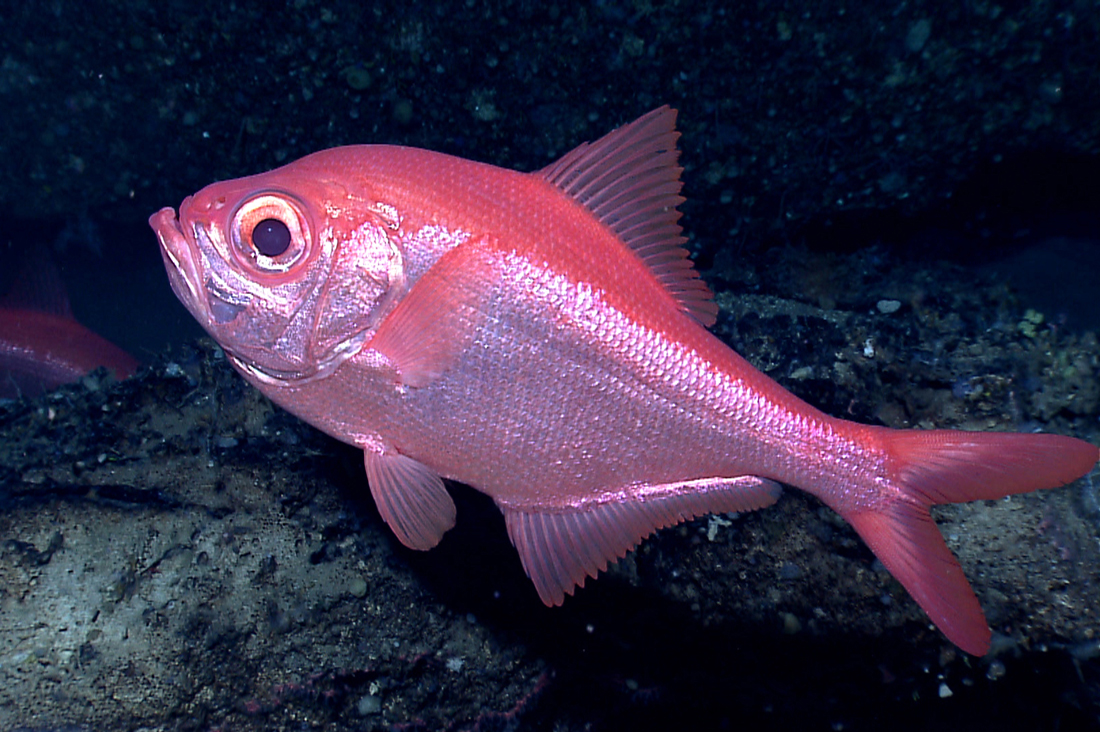- Classification
- ACTINOPTERYGII
- BERYCIFORMES
- BERYCIDAE
- Beryx
- decadactylus
Imperador, Beryx decadactylus Cuvier 1829

An Alfonsino, Beryx splendens, in the northern Gulf of Mexico, march 2012. Source: NOAA Okeanos Explorer Program, Gulf of Mexico 2012 Expedition. License: CC BY Attribution
Imperador, Beryx decadactylus Cuvier 1829
More Info
|
Distribution |
Coral Sea, Queensland, around southern Australia, to off Jurien Bay, Western Australia; also off Christmas Island in the eastern Indian Ocean, and the Norfolk Ridge, south of Norfolk Island, in the Tasman Sea. Records from South Australia and Western Australia require confirmation. Elsewhere the species is circumglobal in tropical and temperate waters. The species is benthopelagic on seamounts, ridges and rises, often forming aggregations. Reportedly undertakes vertical migrations to shallower water at night. |
|
Features |
Body deep, compressed body, eye very large, mouth large, oblique; scales small, ctenoid. The species has very large eyes, a large oblique mouth and small ctenoid scales. Dorsal fin single, short-based; anal fin long-based, originating below middle of the dorsal fin; caudal fin deeply forked. |
|
Feeding |
Feeds on fishes, crustaceans and squids. |
|
Etymology |
The specific name decadactylus is from the Latin deci- (= ten) and the Greek daktylos (= finger), in reference to the pelvic fins having 10 soft rays in this species. |
|
Species Citation |
Beryx decadactylus Cuvier, 1829, Histoire Naturelle des Poissons: 222. Type locality: Madeira. |
|
Author |
Bray, D.J. 2020 |
|
Resources |
Imperador, Beryx decadactylus Cuvier 1829
References
Cuvier, G.L. in Cuvier, G.L. & Valenciennes, A. 1829. Histoire Naturelle des Poissons. Paris : Levrault Vol. 3 500 pp. pls 41-71.
Shotton, R. (ed.) 2016. Global review of alfonsino (Beryx spp.), their fisheries, biology and management. FAO Fisheries and Aquaculture Circular No. 1084. Rome, Italy. 160 pp.
Friess, C. & Sedberry, G.R. 2011. Age, growth, and spawning season of red bream (Beryx decadactylus) off the southeastern United States. Fishery Bulletin 109: 20-33.
Hobbs, J-P.A., Newman, S.J., Mitsopoulos, G.E.A., Travers, M.J., Skepper, C.L., Gilligan, J.J., Allen, G.R., Choat, H.J. & Ayling, A.M. 2014. Checklist and new records of Christmas Island fishes: the influence of isolation, biogeography and habitat availability on species abundance and community composition. Raffles Bulletin of Zoology Supplement 30: 184–202 https://lkcnhm.nus.edu.sg/rbz/supplement-no-30/
Iwamoto, T., Russell, B., Polanco Fernandez, A., McEachran, J.D. & Moore, J. 2015. Beryx decadactylus. The IUCN Red List of Threatened Species 2015: e.T198578A21910085. https://dx.doi.org/10.2305/IUCN.UK.2015-4.RLTS.T198578A21910085.en. Downloaded on 26 October 2020.
Kuiter, R.H. 1994. Family Berycidae. pp. 392-398 figs 352-357 in Gomon, M.F., Glover, C.J.M. & Kuiter, R.H (eds). The Fishes of Australia's South Coast. Adelaide : State Printer 992 pp. 810 figs.
Paxton, J.R. 1999. Family Berycidae. pp. 2218-2224 in Carpenter, K.E. & Niem, T.H. (eds). The Living Marine Resources of the Western Central Pacific. FAO Species Identification Guide for Fisheries Purposes. Rome : FAO Vol. 4 2069-2790pp.
Roberts, C.D. 2015. Family Berycidae. pp. 1018-1021 in Roberts, C.D., Stewart, A.L. & Struthers, C.D. The Fishes of New Zealand. Wellington : Te Papa Press Vol. 3 pp. 577-1152.
Roberts, C.D. & Gomon, M.F. 2008. Family Berycidae. pp. 415-419 in Gomon. M.F., Bray, D.J. & Kuiter, R.H (eds). Fishes of Australia's Southern Coast. Sydney : Reed New Holland 928 pp.
Yearsley, G.K., Last, P.R. & Ward, R.D. (eds) 1999. Australian Seafood Handbook. Hobart : CSIRO Marine Research 460 pp.





